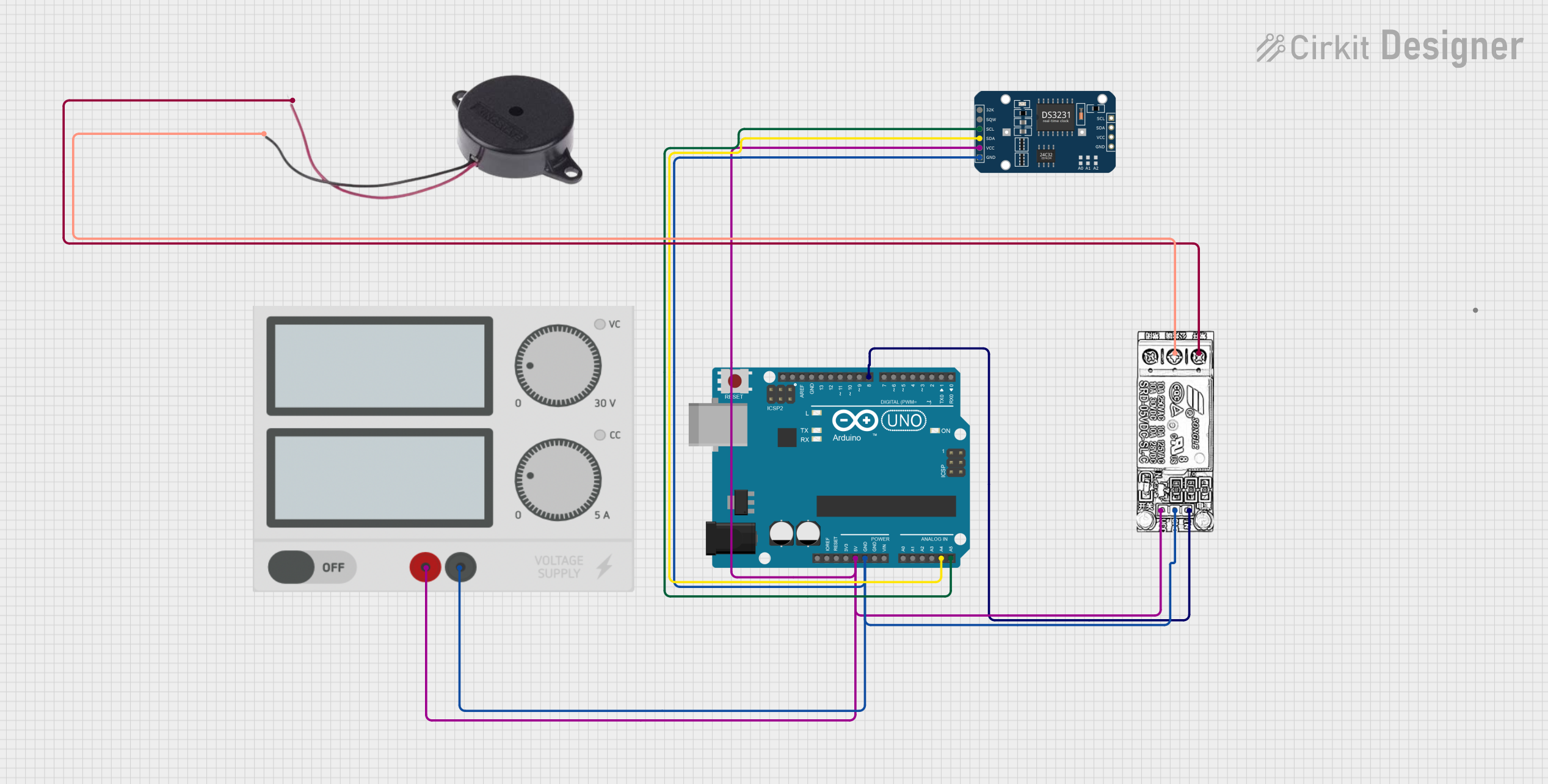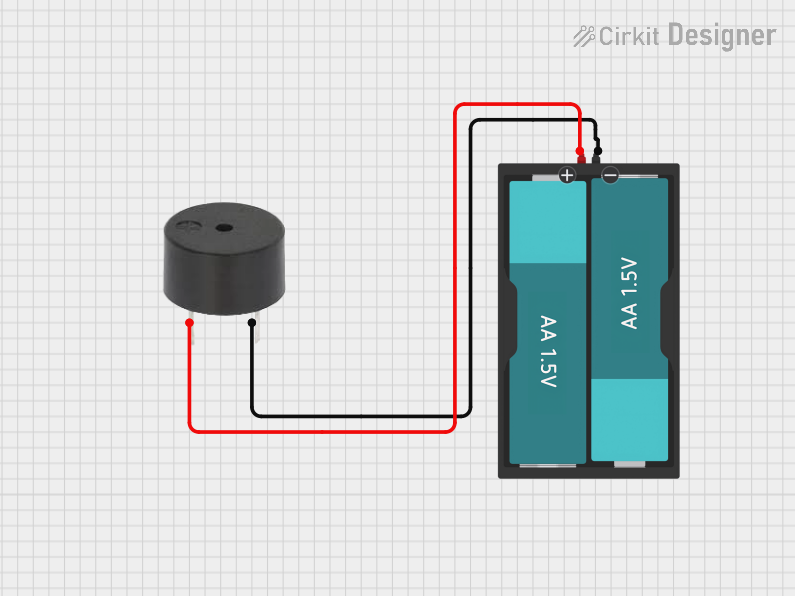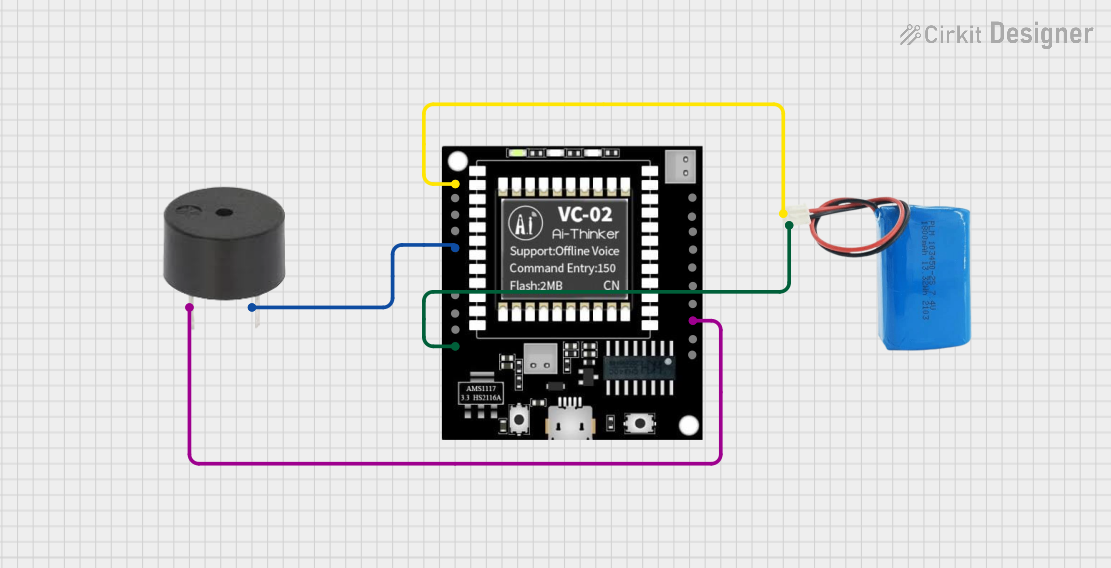
How to Use Buzzer: Examples, Pinouts, and Specs

 Design with Buzzer in Cirkit Designer
Design with Buzzer in Cirkit DesignerIntroduction
A buzzer is an audio signaling device that produces sound when an electric current passes through it. It is commonly used in alarms, timers, notifications, and other systems requiring audible feedback. Buzzers are available in two main types: active and passive. Active buzzers generate sound when powered, while passive buzzers require an external signal to produce sound.
Explore Projects Built with Buzzer

 Open Project in Cirkit Designer
Open Project in Cirkit Designer
 Open Project in Cirkit Designer
Open Project in Cirkit Designer
 Open Project in Cirkit Designer
Open Project in Cirkit Designer
 Open Project in Cirkit Designer
Open Project in Cirkit DesignerExplore Projects Built with Buzzer

 Open Project in Cirkit Designer
Open Project in Cirkit Designer
 Open Project in Cirkit Designer
Open Project in Cirkit Designer
 Open Project in Cirkit Designer
Open Project in Cirkit Designer
 Open Project in Cirkit Designer
Open Project in Cirkit DesignerCommon Applications
- Alarm systems (e.g., burglar alarms, fire alarms)
- Timers and reminders
- Notification systems in appliances
- Feedback in electronic devices (e.g., button presses)
- Educational and DIY electronics projects
Technical Specifications
Below are the general specifications for a typical buzzer. Note that specific values may vary depending on the model and manufacturer.
| Parameter | Specification |
|---|---|
| Operating Voltage | 3V to 12V (commonly 5V) |
| Current Consumption | 10mA to 50mA |
| Sound Output Level | 85dB to 100dB (at 10cm distance) |
| Frequency Range | 2kHz to 4kHz |
| Operating Temperature | -20°C to +60°C |
| Dimensions | Varies (e.g., 12mm diameter) |
Pin Configuration
Buzzers typically have two pins: positive (+) and negative (-). The table below describes the pin configuration:
| Pin | Description |
|---|---|
| Positive (+) | Connects to the positive terminal of the power supply or signal source. |
| Negative (-) | Connects to the ground (GND) of the circuit. |
Usage Instructions
How to Use a Buzzer in a Circuit
- Identify the Type of Buzzer: Determine whether the buzzer is active or passive. Active buzzers only require a DC voltage to operate, while passive buzzers need a PWM (Pulse Width Modulation) signal.
- Connect the Pins:
- For an active buzzer, connect the positive pin to the power supply (e.g., 5V) and the negative pin to ground.
- For a passive buzzer, connect the positive pin to a PWM-capable pin of a microcontroller (e.g., Arduino) and the negative pin to ground.
- Add a Current-Limiting Resistor (if needed): To protect the buzzer and circuit, use a resistor (e.g., 220Ω) in series with the buzzer if the current exceeds the buzzer's rating.
- Test the Buzzer: Power the circuit and verify that the buzzer produces sound.
Important Considerations
- Polarity: Ensure correct polarity when connecting the buzzer. Reversing the connections may damage the component.
- Voltage Rating: Do not exceed the buzzer's maximum voltage rating to avoid damage.
- Mounting: Secure the buzzer to prevent vibrations from affecting other components in the circuit.
Example: Using a Buzzer with Arduino UNO
Below is an example of how to use a passive buzzer with an Arduino UNO to generate a tone.
Circuit Connections
- Connect the positive pin of the buzzer to Arduino pin 9.
- Connect the negative pin of the buzzer to the GND pin on the Arduino.
Code Example
// Example code to generate a tone on a passive buzzer using Arduino UNO
// Define the pin connected to the buzzer
const int buzzerPin = 9;
void setup() {
// No setup required for this example
}
void loop() {
// Generate a tone at 1000 Hz for 500 milliseconds
tone(buzzerPin, 1000, 500);
// Wait for 1 second before repeating
delay(1000);
}
Notes:
- Use the
tone()function for passive buzzers to generate sound at a specific frequency. - For active buzzers, simply set the pin HIGH to turn the buzzer on and LOW to turn it off.
Troubleshooting and FAQs
Common Issues and Solutions
No Sound from the Buzzer:
- Cause: Incorrect wiring or insufficient voltage.
- Solution: Verify the connections and ensure the power supply matches the buzzer's voltage rating.
Buzzer Produces Weak or Distorted Sound:
- Cause: Insufficient current or incorrect frequency (for passive buzzers).
- Solution: Check the power supply and ensure the correct frequency is being applied.
Buzzer Overheats:
- Cause: Exceeding the voltage or current rating.
- Solution: Use a current-limiting resistor and ensure the voltage is within the specified range.
Buzzer Does Not Respond to PWM Signal:
- Cause: Using an active buzzer instead of a passive one.
- Solution: Confirm the type of buzzer and use the appropriate signal.
FAQs
Q: Can I use a passive buzzer without a microcontroller?
A: Yes, but you will need an external oscillator circuit to generate the required frequency.
Q: How do I differentiate between an active and passive buzzer?
A: Active buzzers typically have a built-in oscillator and produce sound when powered. Passive buzzers require an external signal and are usually smaller in size.
Q: Can I control the volume of a buzzer?
A: The volume of most buzzers is fixed. However, you can reduce the volume by lowering the supply voltage (within the operating range).
Q: Is it safe to connect a buzzer directly to a GPIO pin?
A: For active buzzers, yes, as long as the current draw is within the GPIO pin's limits. For passive buzzers, use a resistor or transistor to avoid overloading the pin.